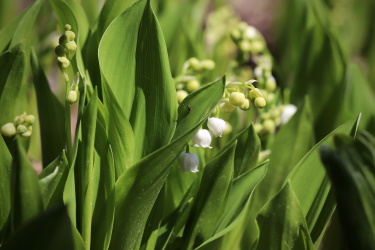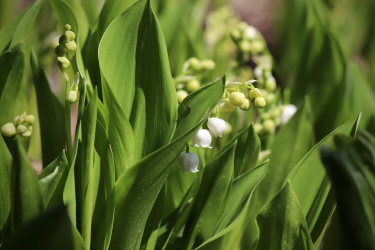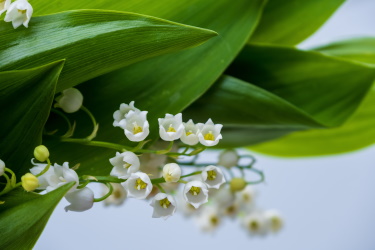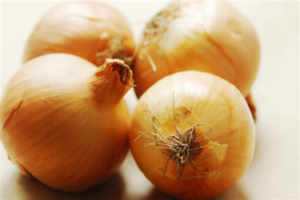
Lily Of The Valley – Planting Basics And Growing Tips:
Lily of the valley, botanically Convallaria Majalis, stands out as one of the most heavenly fragrant and elegantly vibrant spring plants. The plant is a perennial, herbaceous and flowering type that is native to Europe but grown all over the northern hemisphere, Asia and America.
Lily of the valley has the fascinating blooms that are flawlessly crafted in a bell-shaped design and retains a pearly white color that adds to the beauty of this plant. The leaves are a perfect shade of green and stay all year round, except for extreme summers.
#MythologyMonday On the “Lilly Of The Valley” which is in Serbian called Djurdjevak (St George’s flower), Young Sun Gods, dragons and “beginning of summer” rituals: https://t.co/eJwVsy3fwX pic.twitter.com/q4gzGuNg36
— oldeuropeanculture (@serbiaireland) April 6, 2020
You would also find the plant under different names like may bell, may lily, mary’s tears, Muguet or our lady’s tears, though, the most popular name is -of course- Lily Of The Valley.
Table of Contents
When to plant Lily of the valley?
If you’re really fond of this gorgeous plant and want your garden to smell like lilies all the time, you can cultivate these plants almost all year round. However, the best time to grow this plant is late fall, i.e., mid-September to mid- October and mid-March to April.
You can always adjust your soil to make it suitable for your lily of the valley, to grow. If the soil is not well-draining, add compost, peat, or any other organic matter. And if your soil is dry, add a sufficient quantity of water to make it moist so your lilies can thrive.
The most important thing to consider -while planting lily of the valley- is the location and planting conditions. Some of the planting conditions are mentioned below:

A light to medium shade is enough for the plant to flourish. Excessive sun exposure can cause the flowers to wilt and die.
Expect your lily of the valley to be a heavy drinker as they require a pretty good amount of water to grow.
Fertilizers are needed, but in a moderate amount, for the plant to grow properly. A good quality compost or mulch would be enough to flood your Lillies with the right amount of nutrients.
Lily Of The Valley Growing Tips:
Growing this uniquely perfumed plant is easier than you would think. Just a few right steps, and you will see your garden/lawn with the perfect swath of green leaves and stalks, bearing white flowers.
Here we have broken down the growing tips into steps to make it easier for you to understand:
As discussed above, the location should be shady enough with well-draining soil. Lily of the valley loves moisture, but standing water will be problematic so you can add compost or manure to increase the drainage.
Take your planting tips “Pips” and cut off the roots a bit to activate the growth process.
Now dig a hole, deep enough to accommodate most of the root in it, leaving just a few centimetres of the lily of the valley shoot above the soil.
The pips or sprouts should at least be 4 inches apart, to avoid overlapping of the roots while growing.
Once the pips are planted, water them well and allow them to settle for a while. You will see the tips growing in a few days.
Once the tips start growing, each stalk will bear 10 to 15 inverted, bell-shaped, dazzlingly white colored flowers. You can cut the flowers and leave the stalks behind.

The flowers will bloom for about 3 to 4 weeks and then start to fall off. After the flowering season, there is no need to cut the foliage. The foliage will serve as a beautiful ground cover for your garden/lawn.
The foliage will again start to bear flowers in the upcoming blooming season.
A pro tip here: Soak your pips in slightly warm water before planting into the ground, this will cause the roots to swell up and will kick start the growing process.
How to care for Lily of the valley after it blooms?
Growing Lily of the valley is quite easy, as compared to taking care of the plant. Once the plant produces blooms, you have to pay extra attention to the plant, to avoid any fungus or pests invasion.
Clean the soil surrounding the plant to free it from debris, fallen leaves, and additional scrap.
Remove the weeds growing around the roots of the plants by pulling them from the ground.
Cut unwanted, wilted, or dead flowers/leaves from time to time to promote the growth of new buds.
The plant is likely to get infested by aphids, so avoid aphids by washing the leaves with clean water. In case of an excessive aphid invasion, use an insecticidal spray or oil.
If you find black or brown patches on the leaves, this could be a sign of anthracnose. Apply a fungicide on the leaves after every 15 days to get rid of this condition.
Fertilize the soil three or four times a year with a good-quality fertilizer.
Water moderately to avoid rotting of the roots and leaves.
Replant your lily of the valley after every three years by digging out the roots. Chop the roots off with a knife and bury one bunch of roots at every 4-inch distance to avoid overcrowding.
Growing Lily Of The Valley In Pots:
Lily of the valley is also ideal for growing indoors in a pot, container or urn. You can grab a handful of flowers from your terrace to make an exceptionally beautiful lily of the valley bouquet. The plant is easy to grow in pots and makes your terrace a sight to glimpse with its ornamental aesthetics.
You can buy the roots from the market or online. And you can also use your previously planted rhizomes for cultivating the fresh plants.
Dig up for the rhizomes in your garden and grab a handful of roots along with shoots. Wash them well and snip some of the roots to make them adjustable according to your pot.
The planting conditions are pretty much the same with the pot cultivation of Lily of the valley.
Grab a medium-sized pot and fill it with well-draining gardening soil.
Make sure that your pot has some holes for proper water drainage.
Take one crown per pot and plant it in the soil so that the whole bunch of root is inside the soil.
The tip of the shoot should be outside the soil.
Add compost and water regularly.
Your blooms will start to appear in a few weeks.
Remember the tip, right? Don’t forget to soak your pips for half an hour in lukewarm water to make them work well.
Lily Of The Valley Companion Plants:
For the gardening freaks –who love to enjoy a variety of different plants with exotic flowers and tall standing shoots– there are a lot of options to accompany their lily of the valley harvest. If you’re not just a ground cover admirer, you can add other shrubs and tall growing plants in your garden too.
Some friendly companions for your lily of the valley plants can be Hostas, coleus, heuchera, hardy geranium, digitalis, and lamium. These plants have almost the same requirements as that of Lily of the valley and hence, can germinate well along with lily of the valley.
Color contrasting companions:
Bleeding heart (Lamprocapnos), columbine (Aquilegia), lady’s mantle (Alchemilla Alpina), ostrich plume, and peach blossom are some of the plants that make a great color contrast with the white blooms of lily of the valley.
Tall standing companions:
Grandiflora Alba, commonly known as bellflower (Campanula persicifolia) or phlox (Phlox paniculata) commonly known as Bright Eyes, will add height to your garden as they stand tall up to 5 feet.
Purpose And Uses Of Lily Of The Valley:
An important ingredient of perfumes:
The strong yet sweet aroma of these flowers makes it ideal to be used in perfumes and other scented fragrances, including soaps and scented candles.
Used in folk medicine and remedies:
The plant contains some chemicals that have been used in folk medicine in ancient times. However, the plant is poisonous, and only herbalists can tell the exact composition of chemicals to be added to avoid any hazard that can possibly occur.
Serves ornamental purpose:
The intricate and gorgeous flowers of Lily of the valley makes an outstanding ornamental plant. It has also been seen as decorative elements in weddings and a much-adored option for bridal bouquets.
Lily Of The Valley Poisonous Hazards:
Despite the colorful blooms and delighting scent, the plants pose a serious and hazardous risk to both humans and animals.
All parts of the plants, along with red berries, white flowers, green foliage, and branches are extremely poisonous, so it is advised to plant them away from the reach of the children and pets.
If consumed, the plants can cause serious health crises, including vomits, allergy, skin lesions, blurred vision, and reduced heartbeat. In the worst cases, it can cause seizures and eventually, death.
[embedded content]



